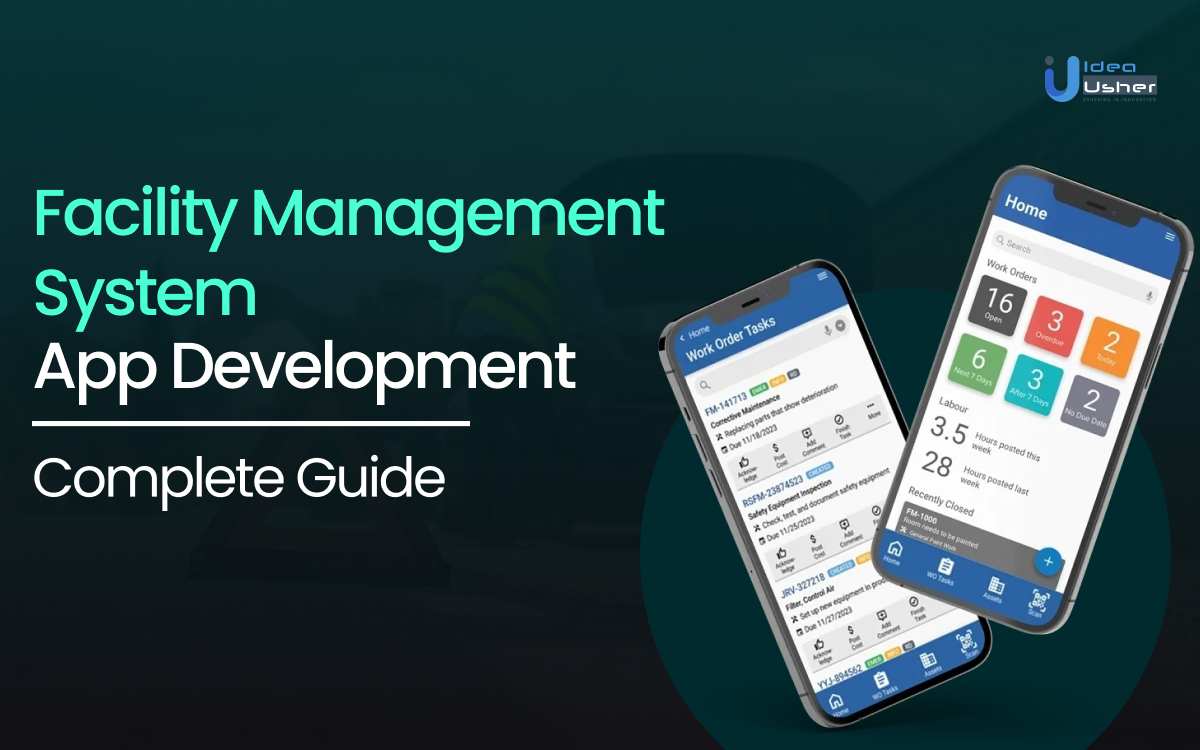Facility management has become a strategic necessity. With the advancement in technology, the complexity within the industries, modern infrastructure, and operations is also increasing. This growing complexity affects daily functions and increases the responsibilities of facility managers. Thus, the demand for efficiency, safety, and optimal resource use makes the role of facility managers more important than ever, which is leading to the need for automatic facility management.
In this blog, we will guide you through the development of a facility management system app that meets these critical needs and creates significant revenue potential. We will outline essential features, discuss strategies to enhance app performance, and offer tips to make your app stand out in the market.
Facility Management System: Overview
Facility management systems are key tools for organizations to effectively oversee and improve their physical assets. These systems were introduced to manage the complexities of modern facilities of daily life. They have transitioned from reactive maintenance to a more proactive approach, improved overall operational efficiency, and reduced downtime.
These systems centralize asset management and provide a clear view of equipment condition, location, and maintenance history. This centralized information helps in making well-informed decisions. They also manage regular maintenance schedules and reduce the risk of unexpected repairs and equipment failures.
They also improve space management by helping plan and use available space effectively as organizations expand. The facility management system also provides users with reporting and analytics features that provide valuable insights into facility performance, aiding better decision-making. There are some modern systems that use technologies like Computer-Aided Facility Management and Enterprise Asset Management to offer integrated solutions for managing complex facilities. Additionally, there are several types of facility management systems that we will explain in the later part of this blog.
Key Features Of Facility Management System
Facility management systems provide essential tools for managing physical assets effectively.
- It simplifies creating, assigning, and tracking maintenance tasks. This feature ensures issues are addressed quickly, reducing delays and enhancing service.
- It helps schedule and track routine maintenance to avoid equipment failures. This proactive approach prevents costly repairs and keeps equipment running smoothly.
- This system helps in maintaining a detailed record of assets, including their condition, location, and maintenance history. This makes asset management easier and more efficient.
- It assists in planning and optimizing the use of available space. This feature ensures that space is used effectively as organizational needs evolve.
- It manages supplies and materials to ensure they are available when needed. This helps prevent interruptions in operations.
- And lastly, it provides valuable insights into facility performance to improve operations.
How Does Facility Management App Work?
Facility management apps simplify the handling of physical assets and operations with several important features.
- These apps are designed with user-friendly interfaces, which makes it easy to navigate and access functions such as work orders, asset management, and inventory from a central dashboard.
- Users can enter information about maintenance tasks, asset conditions, and inspections directly into the app. The app then stores and organizes this data and provides a clear overview of facility operations.
- Many apps offer automation features that schedule maintenance tasks and send reminders automatically. This reduces manual effort and ensures tasks are completed on time.
- The app includes tools for generating reports and analyzing data. Users can track maintenance trends, asset usage, and overall facility performance to make better decisions.
- The app also supports communication among team members and allows them to assign tasks, share updates, and work together on maintenance and inspections.
Key Market Takeaways For Facility Management Software
The facility management software market reported revenues of US$ 20,985.1 million in 2023. It is forecasted to grow significantly, reaching US$ 72,168.4 million by 2033, with a compound annual growth rate (CAGR) of 12.0% during this period. This segment represents around 45% of the global facility management market.
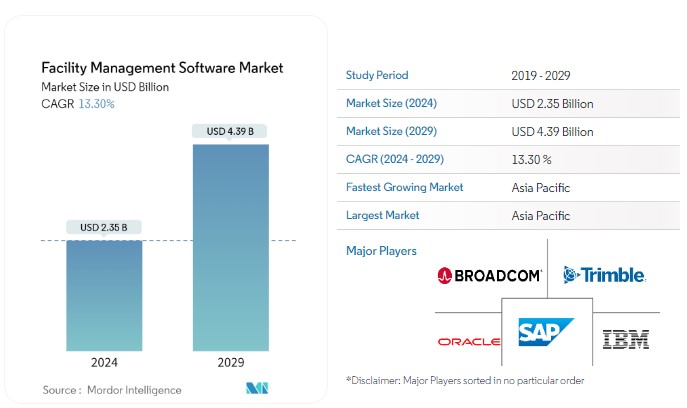
Another report estimates that the facility management software market will be valued at $2.35 billion in 2024 and is projected to expand to $4.39 billion by 2029, with a CAGR of 13.30% over the forecast period.
Facility management encompasses various elements that impact organizational productivity and efficiency. A new management system standard, aligned with industry best practices, establishes a global benchmark for applying FM principles. As large companies and governments focus on infrastructure development, the demand for CAFM (Computer-Aided Facility Management) software is increasing. Governments are partnering with service providers to maintain infrastructure, which is boosting the need for CAFM solutions. Moreover, cloud computing enhances data sharing and flexibility while offering more options for users. However, integration issues with existing systems can slow adoption. Despite this, companies are investing in customized solutions and new technologies to improve efficiency and productivity.
Why Are Facility Management System Apps In Demand?
Facility management system apps are increasingly sought after in 2024 due to several key trends and advancements in technology.
1. Integration Of Advanced Technologies
The adoption of IoT and AI is the primary factor responsible for data-driven decision-making, which is driving demand. IoT devices provide real-time insights into energy use, occupancy, and equipment performance and enhance facility monitoring and management. On the other hand, AI-driven analytics support predictive maintenance and allow organizations to foresee and address potential issues before they become significant problems. This approach minimizes downtime and optimizes asset usage.
2. Focus On Sustainability
As organizations focus more on environmental responsibility, facility management apps help track and manage energy use, supporting sustainability efforts. They ensure facilities meet energy performance standards and implement green practices.
3. Enhanced Efficiency And Productivity
Automation features in these apps handle routine tasks like work order approvals and vendor management, which saves time and reduces costs. Additionally, advanced data analytics provide actionable insights and help users make informed and quicker decision-making.
4. Addressing Labor Challenges
Honestly, there is a shortage of skilled labor, which is impacting the work. Facility management apps offer solutions like automation and remote management capabilities to reduce the need for on-site personnel and enhance overall operational efficiency.
5. Improved Asset Management
Facility management apps track and manage assets more effectively. They use data to predict equipment failures and keep detailed records. This feature ensures better upkeep and fewer unexpected problems and facilitates better management practices.
Types Of Facility Management Software
Facility management software is important for optimizing operations, improving efficiency, and controlling costs. Here are the different types of facility management software:
1. Computer-Aided Facility Management (CAFM) Software
CAFM software is dedicated to managing physical assets, space utilization, and maintenance tasks within an organization. It facilitates asset tracking, space planning, lease management, and preventive maintenance scheduling. Additionally, it helps manage energy usage, ensuring that all resources are utilized efficiently and maintenance tasks are performed proactively to avoid unexpected issues.
2. Computerized Maintenance Management System (CMMS)
CMMS software is focused on streamlining maintenance activities, tracking work orders, and managing equipment upkeep. It includes features for tracking work orders, scheduling preventive maintenance, overseeing inventory, and maintaining equipment history. This software ensures that maintenance tasks are carried out on time. It helps in managing spare parts efficiently and maintains a comprehensive record of equipment performance and repairs.
3. Integrated Workplace Management System (IWMS)
IWMS combines the functionalities of CAFM and CMMS and provides a unified approach to managing the entire workplace environment. It integrates space planning, lease management, asset tracking, and maintenance management with energy control. This solution offers a comprehensive view of facility operations, improves overall efficiency, and allows better decision-making through integrated data and processes.
4. Building Automation System (BAS)
BAS is designed to control and monitor building systems such as HVAC, lighting, and security. It provides real-time data, optimizes energy efficiency, and allows remote control of building systems. With these functionalities, BAS basically ensures that building operations are smooth, energy consumption is minimized, occupants are comfortable, and it allows remote management and adjustments.
5. Workplace Management System (WMS)
WMS focuses on the human aspects of the workplace, managing employee space utilization, reservations, and hot desking. It offers tools for space utilization analysis, booking systems, and collecting employee feedback. This system helps organizations efficiently manage office layouts and adapt to changing workspace needs, ultimately improving employee satisfaction and productivity.
6. Inventory Management System
An Inventory Management System is essential for tracking and managing physical assets, equipment, and supplies. It features barcode scanning, purchase order management, and stock-level monitoring. This software helps organizations keep accurate records of inventory and makes sure that necessary resources are available. This system basically prevents issues related to overstocking or shortages.
7. Energy Management System (EMS)
EMS is aimed at monitoring and optimizing energy consumption within buildings. It provides tools for analyzing energy usage, managing demand response, and integrating renewable energy sources. EMS allows organizations to reduce energy costs, improve sustainability, and gain insights into their energy consumption patterns. Overall, EMS contributes to more efficient and environmentally friendly operations.
8. Facility Management Suite
A Facility Management Suite combines multiple facility management tools into a single, integrated platform. It may incorporate features from CAFM, CMMS, IWMS, and other relevant systems. This comprehensive suite offers a simple solution for managing various aspects of facility operations and provides a unified approach to streamline processes and enhance overall efficiency.
| Type | Focus | Key Features | Pros | Cons |
| CAFM | Comprehensive facility management | Centralized data, space planning, maintenance, asset tracking | Efficient space utilization, enhanced reporting | Requires ongoing training |
| CMMS | Maintenance scheduling and planning | Equipment tracking, compliance, cost management | Reduces downtime, improves efficiency | May need system integration |
| IWMS | Facility and workplace management | Data visibility, space management, real estate, sustainability | Holistic solution | Higher cost, longer implementation |
| EMS | Energy consumption analysis | Energy tracking, savings opportunities | Implements energy-saving solutions | Limited scope, needs additional resources |
Must-have Features For A Facility Management Apps
When developing a facility management app, it’s essential to consider the unique needs of different user roles. Here are the basic features for each panel that would be useful in a comprehensive facility management system:
| Panel | Features |
| Admin Panel | User Management, Dashboard Overview, Facility Management, Reporting & Analytics, Settings & Configuration, Audit Log |
| Manager Panel | Work Order Management, Asset Management, Preventive Maintenance Scheduling, Inventory Management, Team Coordination, Budget Management |
| Technician Panel | Work Order Access, Asset Details, Mobile Accessibility, Time Tracking, Inventory Requests, Issue Reporting |
| Employee/User Panel | Service Requests, Request Tracking, Facility Booking, Feedback & Surveys, Emergency Alerts |
Apart from that, here are some must-have features that can improve the effectiveness of any facility management app:
1. Auto-Scheduling
Auto-scheduling is important for efficient maintenance planning. This feature automatically schedules tasks based on predefined intervals or conditions and eliminates the need for manual intervention. For example, MaintainX has integrated this feature to ensure that maintenance tasks are conducted in a timely manner while reducing unexpected equipment failures and extending asset lifespan.
2. Tenant Request Handling
This feature allows tenants to submit maintenance requests directly through the app, streamlining the process. FMX is a facility management solution that offers this functionality to enhance response times and provide tenants with timely updates. For FMX, this feature results in improved satisfaction and quicker resolution of issues.
3. Equipment Tracking
The accurate tracking feature monitors the status, location, and usage of equipment within the facility. Asset Essentials uses this feature to improve asset management and provides real-time data that minimizes downtime and ensures optimal resource usage.
4. Work Order Management
Proper documentation and assignment of maintenance tasks are, in general, important. Thus, work order management features are introduced to streamline the process. This feature ensures that tasks are assigned to the right personnel and tracked efficiently. Maintenance Care is a prominent name in the market that has employed this feature to enhance team communication and operational workflow. This feature helped users of the platform to ensure that the tasks were completed accurately and on time.
5. Preventive Maintenance
Proactive maintenance is key to reducing costly repairs. Incorporating this feature in the app will make sure to schedule regular maintenance tasks to prevent equipment breakdowns. For example, Fiix utilizes this feature to prolong the lifespan of assets, identify potential issues early, and reduce long-term repair costs.
6. Asset Tracking
Maintaining accurate records of assets is important for accountability. This is why features like real-time asset tracking provide users with insights into the location, status, and usage of all assets. Asset Panda is a popular name today that implements this feature to improve accountability and minimize risks like loss or theft.
7. Space Utilization
Features that can help with optimizing space usage are essential. Such features manage desk and room bookings while helping users to allocate resources effectively. One of the renowned facility management platforms, Clearooms, uses this functionality to provide a clear overview of available spaces. That solution helps users to book the spaces efficiently and optimize their utilization.
8. Inventory Control
It is important to make sure that the necessary supplies are available at all times. Inventory control features within the app can help users manage stock levels, track usage, and oversee replenishment. In the real-world, MarginPoint offers this feature to their users to help them reduce stockouts and ensure that their maintenance teams have the supplies they need. Basically, this feature helps in improving overall efficiency.
9. Reporting And Analytics
Data-driven decision-making is essential almost everywhere, and so is in facility management. Reporting and analytics features help in generating detailed reports on facility performance and provide insights that inform decision-making. There is a facility management app called SafetyCulture that integrates this feature to help managers monitor key metrics, identify trends, and improve operational planning.
10. Cloud-Based Features
Accessibility and flexibility are important for modern facility management. Cloud-based facility management apps offer remote access and allow users to manage facilities from any location. UpKeep is an excellent example here, which provides this feature to enhance collaboration and ensure facility management tasks can be performed from anywhere.
Development Steps For A Facility Management App
Building a top-tier facility management app involves a well-planned sequence of steps:
1. Begin With Comprehensive Research
The process begins with a comprehensive understanding of facility management requirements across different sectors. Analyzing core functions such as work order management, asset tracking, and space utilization helps in identifying the unique challenges of industries like healthcare, manufacturing, and education. It’s essential to familiarize yourself with relevant industry standards and regulations (e.g., ISO 55000, LEED) to ensure compliance from the start. This foundational research informs the app’s design, ensuring it meets the unique requirements of users
2. Design Customizable Asset And Work Order Management
Next, create a system that allows users to customize asset tracking and work order management according to their specific needs. This step should include features like barcode scanning and IoT integration to enhance accuracy and real-time tracking. The design must support different types of work orders, from preventive to emergency maintenance, and allow prioritization based on urgency and other critical factors.
3. Emphasize Predictive Maintenance And Space Optimization
Incorporate predictive maintenance tools that use data analytics to anticipate and schedule maintenance tasks. This approach minimizes downtime and extends asset life. Additionally, focus on space management by allowing users to map out floor plans and optimize space utilization through occupancy tracking. This helps identify and manage underutilized areas efficiently.
4. Integrate Energy Management Tools
Equip the app with features that monitor and analyze energy consumption to help users identify patterns and areas for improvement. The goal is to enhance energy efficiency and reduce environmental impact. Including options for generating sustainability reports will enable organizations to demonstrate their commitment to environmental responsibility.
5. Enhance Safety With Incident Management And Emergency Response
When it comes to safety, the app should include GPS or an incident management system. So, utilize location-based services to efficiently manage emergencies by tracking incidents and dispatching resources. Pre-defined emergency protocols should be embedded within the app to guide teams through crisis situations and ensure a swift, coordinated response.
6. Utilize BIM And BAS Integration For Advanced Control
Incorporating Building Information Modeling to allow users to visualize the facility in detail, facilitating better planning and asset management. Additionally, integration with Building Automation Systems that will help ensure real-time monitoring of building operations like HVAC and lighting. With this integration, you can provide your users with the tools necessary for effective and efficient facility management.
7. Use IoT For Real-Time Monitoring
Deploy IoT sensors across the facility to provide continuous monitoring of equipment and environmental conditions. The data collected can be used to optimize operations in real-time, making adjustments as needed to maintain efficiency. Additionally, by enabling remote control over key systems through the app, you can make sure that facility managers can respond to issues from anywhere.
8. Enhance User Interaction With NLP Capabilities
Finally, incorporate Natural Language Processing to enhance the app’s usability by allowing voice commands for managing tasks. This feature simplifies the interaction with the app, making it more intuitive. NLP can also intelligently direct tasks to the appropriate personnel based on their expertise, ensuring that work orders are handled efficiently.
Tech Stack For Facility Management System Development
Here are the tech stack required for the facility management app development:
| Category | Components | Description |
| Frontend | React Native | Used for building cross-platform mobile applications. |
| Mapbox or Google Maps API | Visualizing facility layouts and asset locations. | |
| Backend | GraphQL | Efficient querying and real-time updates. |
| Firebase | Real-time database and authentication. | |
| Database | PostGIS | Geographic data support. |
| Redis | Caching frequently accessed data. | |
| Infrastructure | Kubernetes | For containerized applications. |
| ElasticSearch | Powerful search capabilities. | |
| Additional Tools | Jira | Tracking development tasks. |
| Twilio | SMS and email notifications. |
Cost Of Developing A Facility Management App
The cost of developing a facility management app can vary widely based on the complexity, features, and the development team’s location. Here are the costs involved in different stages and features:
| Phase | Activities | Minimum Cost | Maximum Cost |
| Discovery Phase | Market research, requirement analysis, feasibility study, project planning | 300 | 2,000 |
| UI/UX Design | Wireframing, prototyping, user interface design, user experience design | 200 | 3,000 |
| Frontend Development | Building the user interface and client-side logic | 500 | 10,000 |
| Backend Development | Setting up the server, database, and server-side logic | 1,000 | 12,000 |
| Feature: | – | – | – |
| Auto-Scheduling | Automatically schedules tasks based on predefined intervals or conditions | 300 | 7,000 |
| Tenant Request Handling | Allows tenants to submit maintenance requests and receive updates | 500 | 5,500 |
| Equipment Tracking | Monitors the status, location, and usage of equipment | 700 | 3,000 |
| Work Order Management | Streamlines the creation, assignment, and tracking of maintenance tasks | 700 | 10,000 |
| Preventive Maintenance | Schedules regular maintenance tasks to prevent equipment breakdowns | 700 | 8,000 |
| Asset Tracking | Provides real-time insights into the location, status, and usage of assets | 800 | 5,000 |
| Space Utilization | Manages desk and room bookings to optimize space usage | 500 | 4,500 |
| Inventory Control | Manages stock levels, tracks usage, and oversees replenishment | 500 | 4,000 |
| Reporting and Analytics | Generates detailed reports on facility performance and provides insights | 1,000 | 10,000 |
| Cloud-Based Features | Offers remote access and allows users to manage facilities from any location | 1000 | 7,000 |
| Testing and QA | Functional testing, performance testing, security testing, user acceptance testing | 300 | 2,000 |
| Deployment | Deploying the app to production, app store submission, initial monitoring | 500 | 2,000 |
| Maintenance and Support | Bug fixes, updates, ongoing support | 500 | 5,000 |
| Total Cost Range | – | $10,000 | $100,000 |
Cost-Affecting Factors To Consider For Facility Management App Development
Here are several cost-affecting factors that must be addressed to ensure a successful facility management app:
- Integrating with BAS systems can vary in complexity, which influences both development time and costs. Higher complexity and greater data volume increase server requirements and overall expenses.
- The costs associated with integrating IoT devices, such as sensors or actuators, depend on their number and type. Additionally, handling data processing for storage, analysis, and visualization will impact the budget.
- Incorporating augmented and virtual reality involves investing in specialized hardware and creating high-quality content, such as 3D models. These requirements can drive up the costs significantly.
- Implementing accurate geolocation and real-time tracking requires precise mapping APIs and additional server resources, which can affect the overall cost.
- Developing features to analyze energy consumption and calculate carbon footprints requires specialized expertise and complex algorithms, adding to the development costs.
- Lastly, ensuring adherence to data privacy regulations and industry sustainability standards involves additional security measures and certifications, which also influence the total expenditure.
Top Trending Revenue Generating Methods For Facility Management Apps
Here are some of the top methods for facility management apps to generate revenues:
1. Premium Asset Performance Services
Facility management apps can generate revenue by offering advanced asset performance services. This includes predictive analytics that forecast maintenance needs and energy efficiency consulting. Both services provide high value by improving asset longevity and reducing operational costs, which users are willing to pay for.
2. Consulting For Sustainability
Revenue can be boosted through consulting services aimed at achieving sustainability goals. This includes assisting facilities in obtaining green certifications like LEED and providing strategies for reducing carbon footprints. These specialized services cater to the growing demand for environmental responsibility and are a profitable revenue stream.
3. Compliance Management Solutions
Apps can offer paid compliance management services such as regulatory audits and training programs. Ensuring adherence to regulations (e.g., OSHA, EPA) is important for facilities, and the need for expert guidance presents a valuable opportunity for generating revenue through subscription or service fees.
4. Customized Disaster Recovery Plans
By developing personalized disaster recovery plans and providing crisis management training, apps can offer premium services. Facilities need to be prepared for emergencies, and customized planning solutions are a valuable service that can command significant fees.
5. Integration With BAS
Offering enhanced integration services with Building Automation Systems (BAS) can be a profitable venture. Apps that provide advanced data analytics and remote monitoring capabilities can charge for these high-value features, as they help facilities operate more efficiently and manage energy consumption.
6. Virtual Facility Tours
Charging for virtual facility tours is a growing revenue stream. These tours are useful for property marketing and remote inspections. Facilities and real estate professionals are willing to invest in virtual solutions that enhance property visibility and streamline inspections.
7. Specialized Marketplace
Creating a marketplace for facility management services such as maintenance and cleaning can generate revenue through transaction fees or subscriptions. By vetting and listing service providers, apps can earn fees from both service providers and facility managers.
Top 5 Facility Management Apps In 2024
Here are the top choices of facility management apps in 2024. Each of them offers unique features designed to simplify various aspects of facility operations.
1. MaintainX
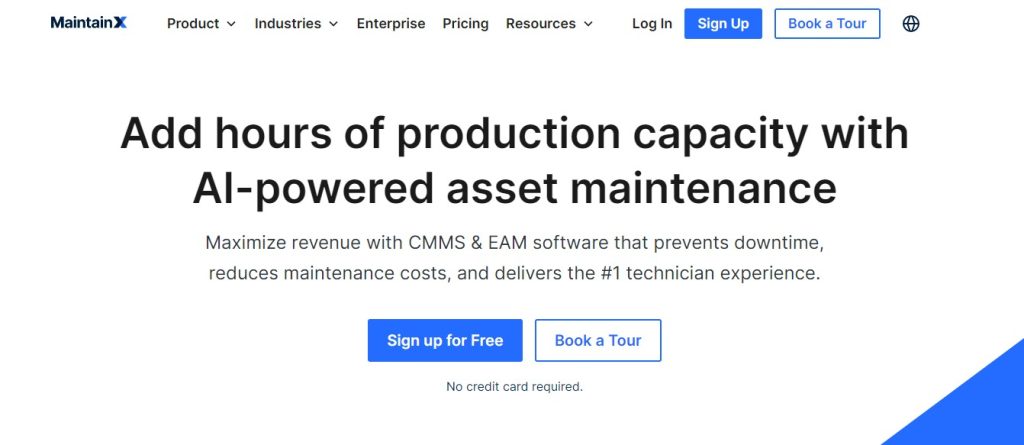
This solution stands out for its comprehensive approach to maintenance and operations. It allows users to create detailed work orders, track their progress, and incorporate photos to improve clarity. The app’s dynamic SOPs adjust based on user input and enhance flexibility. Its mobile functionality enables users to manage tasks and access features from any location and makes it a versatile tool for maintaining and managing assets.
2. UpKeep
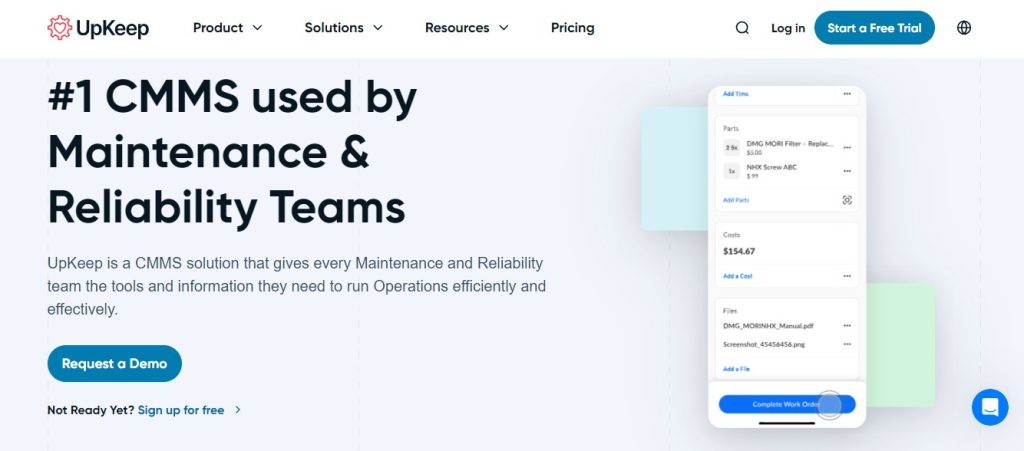
This app is designed with a mobile-first approach, which makes it ideal for facility and manufacturing managers. The app offers real-time updates and an intuitive interface for managing work orders, inventory, and preventive maintenance tasks. UpKeep’s mobile capabilities ensure that users can handle all functionalities while on the move and support continuous operations and efficient maintenance management.
3. FMX

FMX provides a cloud-based solution suitable for educational institutions and other organizations. It excels in managing work orders and allows the efficient creation, assignment, and tracking of tasks. FMX also features interactive asset mapping, which helps users visualize the locations of assets and spaces. Additionally, its reporting tools deliver insights into maintenance activities and operational performance.
4. SafetyCulture
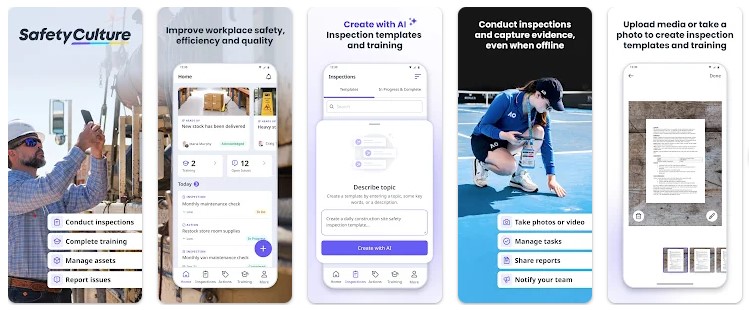
SafetyCulture was formerly known as iAuditor. This app is renowned for its inspection management capabilities. Users can design and conduct inspections using customizable forms while ensuring consistent data collection. The app supports real-time issue reporting and provides analytics through dashboards to monitor performance and trends. With full mobile access, SafetyCulture facilitates effective inspection and compliance management.
5. eMaint
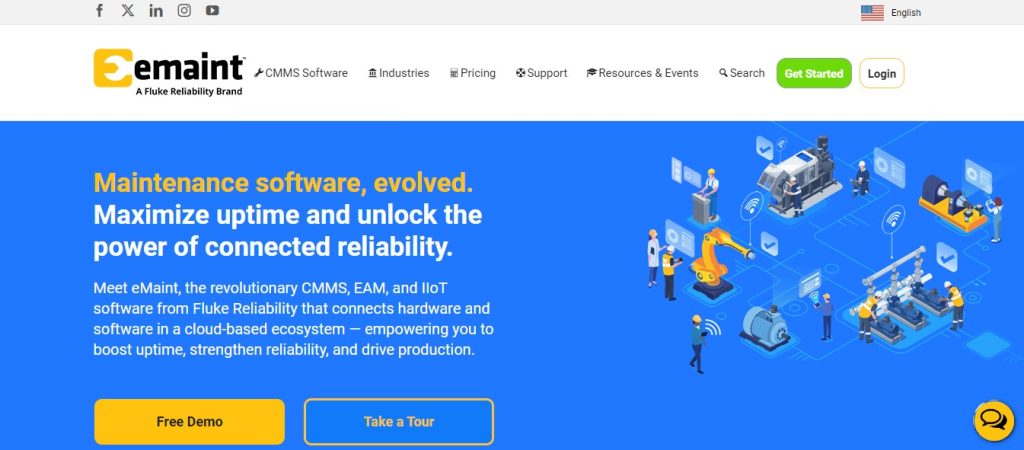
eMaint is a versatile mobile CMMS that supports various maintenance management tasks. It features detailed work order tracking, including photo attachments and checklists, to ensure task accuracy. eMaint also provides asset management and inventory control, helping users maintain comprehensive records and manage spare parts. Its offline capabilities allow access to essential features without an internet connection, ideal for field operations.
Conclusion
Effective facility management systems are important for modern operations as they provide simple processes that boost overall productivity. As facilities grow in complexity, integrating advanced technology becomes essential for smooth management. These systems help organizations uphold high standards by offering reliable tools for both routine and unforeseen tasks. With growing demands for transparency and efficiency, investing in a comprehensive facility management solution is the basic need for enhancing productivity and extending the life of assets. Moreover, continuous advancements in this field promise increasingly effective solutions, making it a key area for organizations aiming to optimize their operations.
Looking To Develop Facility Management Software?
We excel in creating custom solutions to streamline your operations. From managing assets and tracking maintenance to optimizing space and improving efficiency, our expertise covers all aspects of facility management. We focus on user-friendly design and amazing functionality to meet your specific needs. With our skilled team, you can expect a solution that integrates seamlessly with your existing systems and scales with your business. Let us help you enhance productivity and reduce costs with a custom-built facility management tool. Contact us today to get started.
Work with Ex-MAANG developers to build next-gen apps schedule your consultation now
FAQ
What is a facility management application?
A facility management application is a software tool that helps organizations efficiently manage and maintain their physical assets, including buildings, equipment, and infrastructure. It simplifies tasks such as scheduling maintenance, tracking assets, managing space, and allocating resources. This software enhances overall operational efficiency, ensuring that facilities remain safe, compliant, and well-maintained.
What are the 3 key concepts of facility management?
The three key concepts of facility management include space and asset management, which involves the effective utilization and upkeep of physical spaces and assets; maintenance and operations, which focus on ensuring that equipment and facilities are properly maintained and functional; and safety and compliance, which emphasize adherence to safety standards and regulatory requirements to protect both occupants and assets.
How much does facility management software cost?
The cost of facility management software can vary significantly, typically ranging from $1,000 to $10,000 per year for small to medium-sized organizations. For larger enterprises, the costs can be substantially higher, often exceeding $50,000 annually, depending on the software’s features, the number of users, and the level of customization required to meet specific needs.
What is the difference between CAFM and CMMS?
CAFM, or Computer-Aided Facility Management, is focused on the strategic planning and management of physical spaces and assets, offering features such as space planning, resource management, and real estate management. In contrast, CMMS, or Computerized Maintenance Management System, is more concerned with the operational aspects, managing maintenance tasks, work orders, and the upkeep of equipment to ensure everything runs smoothly.
